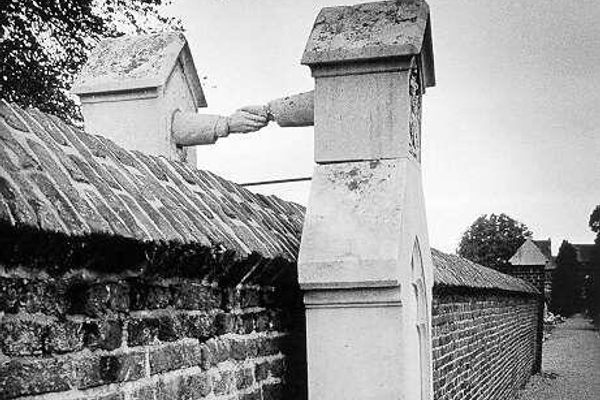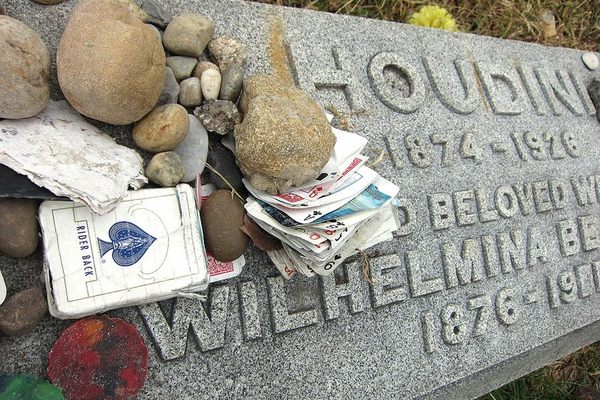Robertson’s Fantastic Phantasmagoria, An 18th Century Spectacle of Horror
Detail of Robertson’s Tomb in Père Lachaise Cemetery (all photographs by the author)
In the smoky haze of an abandoned convent in Paris, ghosts were conjured out of the afterlife to a horrified, yet mesmerized, crowd. The spirits in this show of phantasmagoria were the work of Étienne-Gaspard Robert, who assumed the stage name of Robertson, a man interested in both spectacle and science at the end of the 18th century, when France had just experienced its brutal Revolution, and the wake of the bloody Reign of Terror trailed a fascination with death and the macabre.
A skeleton reaper in a magic lantern show (via Magic Lantern Shows)
Robertson was a pioneer of phantasmagoria, the early spectacle of horror and mysticism where illusions of the resurrected dead entertained and terrified crowds in the late 18th and early 19th centuries. His tomb in Père Lachaise Cemetery in Paris reflects his legacy with a bas-relief of a horde of skeletons and demons menacing a well-heeled audience of onlookers. Robertson also had a thing for ballons, and the other side of his Père Lachaise tomb is engraved with a dirigible scene from his participation in the dawn of aviation.
Bas-relief of a balloon ride on the tomb of Robertson
Born in 1763 in Liège, Belgium, Robertson initially set out on a rather standard path for a curious scholar, studying in Leuven and then becoming a physics professor. Yet while this allowed him to research intensely his interest in optics, what he really want to do was paint, and in 1791 he moved to a Paris that was still in the tumults of the French Revolution.
He first stepped into the public eye in 1793 with a scheme to use mirrors as a defense against the British navy, a ship-scorching idea he adopted from the story of Archimedes’ “Heat Ray” from around 214-212 BC, which is said to have incinerated enemy ships with mirrors. The government wasn’t thrilled with the idea, and it wouldn’t be his last failure to win over the local authorities, as Robertson was constantly pushing the boundaries of the fantastic with the real in a visible way.
Robertson’s phantasmagoria show (via metalonmetalblog)
Long interested in the supernatural, his love of art and physics merged into phantasmagoria, its name roughly meaning a gathering of ghosts. He’d been inspired by Paul Philidor’s magic lantern shows, as well as reading on 17th century scholar Athanasius Kircher’s lantern and the contemporary shadow plays of Françcois Dominique Séraphin, and decided with all his optics knowledge he could do even better. So he built a magic lantern on wheels called the Fantoscope, and with it he could not only project layers of images all at once, but move around so as to make the figures appear to approach the audience. This combined with a spooky candlelit room he set up in the run down Couvent des Capucines near the Place Vendôme, as well as an introduction by Robertson on the afterlife, eerily monotonous accompaniment from a glass harmonica, and ventriloquism for the ghouls, made for a most unsettling evening.
According to the Glass Armonica, the advertisement for his first performance in 1798 read:
Fantasmagorie … by citizen E-G. Robertson: apparitions of Spectres, Phantoms and Ghosts, such as must appear or could appear in any time, in any place and among any people. Experiments with the new fluid known by the name of Galvanism, whose application gives temporary movement to bodies whose life has departed. An artist noted for his talents will play the Harmonica.
A sketch by Robertson for a performance called “Dance of the Sorcerers” (via skullinthestars)
And Paris loved it, as did the world he traveled with his horror show, although the authorities at first shut him down as his audience thought the ghosts were real. They may have also been concerned about his smoke made from aqua fortis (nitric acid) with sulphuric acid. Yet his spectacles continued and evolved for years, heavily influencing the horror theater and later cinema that would come after.
Skulls on Robertson’s tomb
He died in 1837, but a wanderer through Père Lachaise is likely to take a second look at his towering skull-studded tomb with its curious bas-reliefs of ghouls and aviation, perhaps feeling some shadow of his lingering love of creeping his audience out. As he once said: ”I am only satisfied if my spectators, shivering and shuddering, raise their hands or cover their eyes out of fear of ghosts and devils dashing towards them; if even the most indiscreet among them run into the arms of a skeleton.”
Tomb of Robertson in Père Lachaise Cemetery
RIP ROBERTSON: PERE LACHAISE CEMETERY, Paris, France

















Follow us on Twitter to get the latest on the world's hidden wonders.
Like us on Facebook to get the latest on the world's hidden wonders.
Follow us on Twitter Like us on Facebook